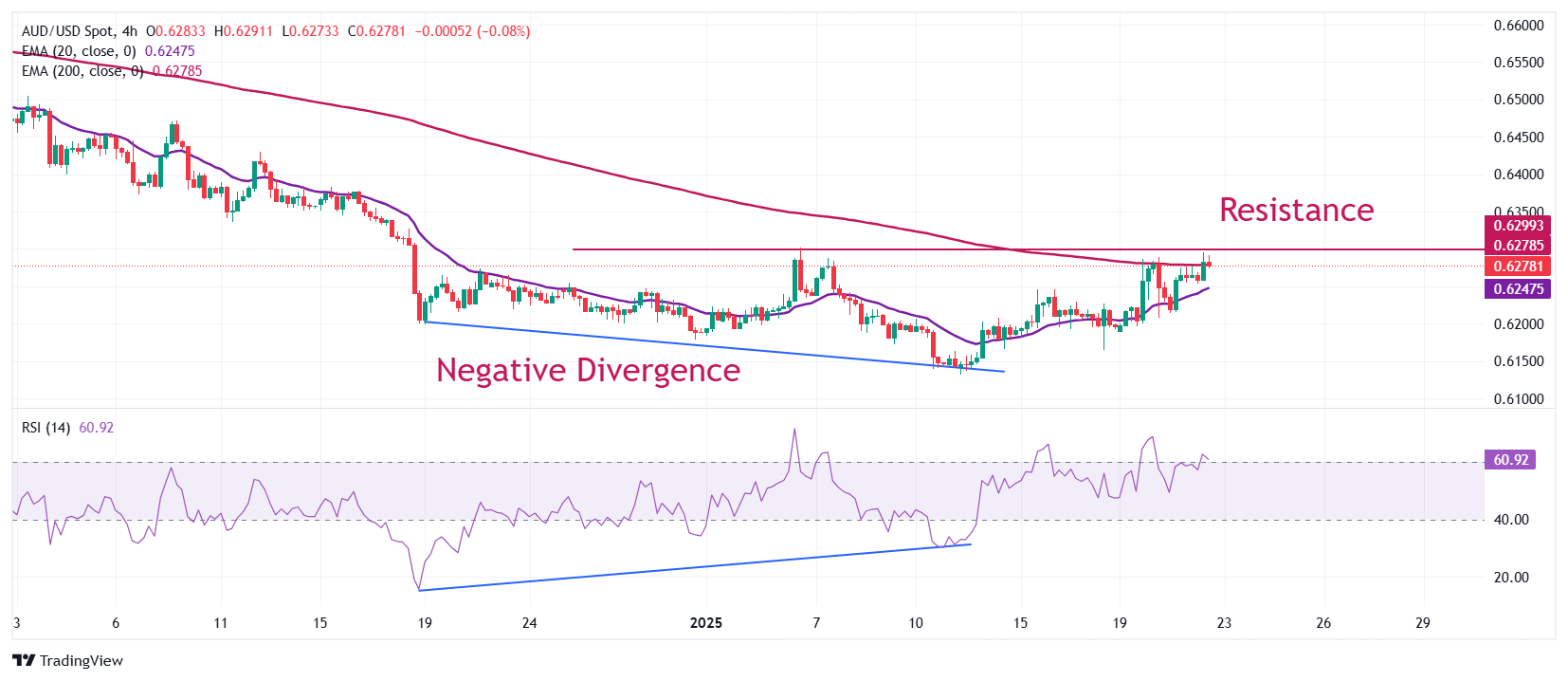AUD/USD Price Forecast: Stage is set for bullish reversal
- AUD/USD rises to the monthly high around 0.6300 as Trump threatens lower tariffs on China than feared.
- The USD Index bounces back after refreshing a two-week low near 107.75.
- Investors await the flash US S&P Global PMI data for January
The AUD/USD pair revisits the monthly high around 0.6300 in Wednesday’s North American session. The Aussie pair ticks higher as the Australian Dollar (AUD) gains on reports that United States (US) President Donald Trump threatens to raise 10% tariffs on China from February 1.
The amount of tariff hikes proposed by Trump is significantly lower than what market participants had anticipated. In the election campaign, Trump said that he would impose 60% tariffs on China if he won the elections. Any economic development in China significantly impacts the Australian dollar, given that Australia is China's leading trading partner.
Meanwhile, the US Dollar (USD) recovers its intraday losses after posting a fresh two-year high, with the US Dollar Index (DXY) rebounds from 107.75.
Going forward, investors will focus on the preliminary US S&P Global Purchasing Managers’ Index (PMI) data for January, which will be published on Friday.
AUD/USD bounces back from a more-than-four-year low of 0.6170. The pair rebounded after a divergence in momentum and price action. The 14-period Relative Strength Index (RSI) formed a higher low, while the pair made lower lows on a four-hour timeframe.
The asset has recovered to near the 200-period Exponential Moving Average (EMA) near 0.6300. The 20-day EMA slopes higher near 0.6247, suggesting that the near-term trend has turned bullish.
Going forward, a sustenance move above 0.6300 will open doors to the December 18 high of 0.6340 and the round-level resistance of 0.6400.
On the flip side, the pair would face more downside if it fails to hold the January 13 low of 0.6131. This will push it lower to the round-level support of 0.6100 and the April 2020 low of 0.5990.
AUD/USD four-hour chart

Australian Dollar FAQs
One of the most significant factors for the Australian Dollar (AUD) is the level of interest rates set by the Reserve Bank of Australia (RBA). Because Australia is a resource-rich country another key driver is the price of its biggest export, Iron Ore. The health of the Chinese economy, its largest trading partner, is a factor, as well as inflation in Australia, its growth rate and Trade Balance. Market sentiment – whether investors are taking on more risky assets (risk-on) or seeking safe-havens (risk-off) – is also a factor, with risk-on positive for AUD.
The Reserve Bank of Australia (RBA) influences the Australian Dollar (AUD) by setting the level of interest rates that Australian banks can lend to each other. This influences the level of interest rates in the economy as a whole. The main goal of the RBA is to maintain a stable inflation rate of 2-3% by adjusting interest rates up or down. Relatively high interest rates compared to other major central banks support the AUD, and the opposite for relatively low. The RBA can also use quantitative easing and tightening to influence credit conditions, with the former AUD-negative and the latter AUD-positive.
China is Australia’s largest trading partner so the health of the Chinese economy is a major influence on the value of the Australian Dollar (AUD). When the Chinese economy is doing well it purchases more raw materials, goods and services from Australia, lifting demand for the AUD, and pushing up its value. The opposite is the case when the Chinese economy is not growing as fast as expected. Positive or negative surprises in Chinese growth data, therefore, often have a direct impact on the Australian Dollar and its pairs.
Iron Ore is Australia’s largest export, accounting for $118 billion a year according to data from 2021, with China as its primary destination. The price of Iron Ore, therefore, can be a driver of the Australian Dollar. Generally, if the price of Iron Ore rises, AUD also goes up, as aggregate demand for the currency increases. The opposite is the case if the price of Iron Ore falls. Higher Iron Ore prices also tend to result in a greater likelihood of a positive Trade Balance for Australia, which is also positive of the AUD.
The Trade Balance, which is the difference between what a country earns from its exports versus what it pays for its imports, is another factor that can influence the value of the Australian Dollar. If Australia produces highly sought after exports, then its currency will gain in value purely from the surplus demand created from foreign buyers seeking to purchase its exports versus what it spends to purchase imports. Therefore, a positive net Trade Balance strengthens the AUD, with the opposite effect if the Trade Balance is negative.

